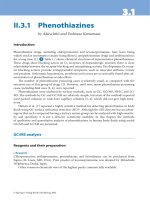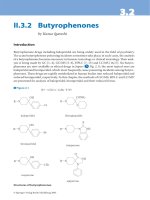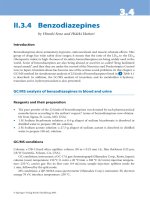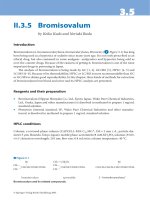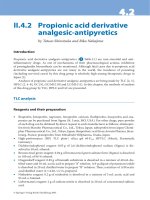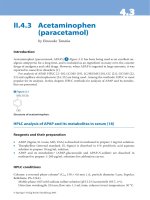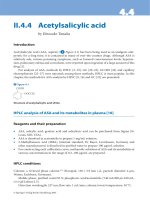Tài liệu Drugs and Poisons in Humans - A Handbook of Practical Analysis (Part 10) pdf
Bạn đang xem bản rút gọn của tài liệu. Xem và tải ngay bản đầy đủ của tài liệu tại đây (210.46 KB, 10 trang )
II. Chapters on specific toxins
1.1
1.1
© Springer-Verlag Berlin Heidelberg 2005
II.1.1 Carbon monoxide
By Keizo Sato
Introduction
e incidence of carbon monoxide ( CO) poisoning is highest among those of various poison-
ings in forensic science practice; about 2/3 of the total accidental poisoning deaths is due to CO
poisoning in Japan [1]. Previously, suicides, homicides and accidental deaths frequently took
place using city gas containing about 9% CO. However, during recent years, city gas is being
replaced by natural gas containing no CO, resulting in drastic decrease of the number of CO
poisoning cases. Nevertheless, many incidents of CO poisoning are occurring due to imperfect
combustion, re, exhaust gas of automobiles and other causes. For a victim found at the scene
of a re, the saturation ratio of carboxyhemoglobin ( COHb) can be an indicator
a
for judging
whether the victim has died in a re or had been already killed before the re.
For measurements of COHb saturation ratios in blood, spectrophotometric and GC meth-
ods are available. Since methemoglobin ( Met-Hb) is contained in many of blood specimens in
forensic science practice for measurements of COHb saturation [2], it is important to use a
method
b
, which is not in uenced by the presence of Met-Hb. In this chapter, simple and reli-
able spectrophotometric [3] and GC [4] methods for measurements of COHb saturation not to
be in uenced by Met-Hb are presented.
Spectrophotometric method
See [3].
Reagents and their preparation
• 0.1% Na
2
CO
3
solution: 0.1 g Na
2
CO
3
is dissolved in distilled water to prepare 100 mL solu-
tion.
• 5 M NaOH solution: 20 g NaOH is dissolved in distilled water to prepare 100 mL solu-
tion.
• Sodium hydrosul te (sodium dithionite) obtainable from Yoneyama Yakuhin Kogyo Co.,
Osaka and other manufacturers.
Analytical instrument
A Hitachi 557 dual-wavelength spectrophotometer (Hitachi, Ltd., Tokyo, Japan)
92 Carbon monoxide
Procedure
i. Two 3-ml volume cuvettes of the same type are cleaned well by washing with distilled
water.
ii. A 2.5-mL volume of 0.1% Na
2
CO
3
aqueous solution is placed in a cuvette.
iii. About 2 mg of solid sodium hydrosul te is added to the above cuvette and mixed well.
iv. A 10-µL volume of whole blood and 0.2 ml of 5 M NaOH solution are added to the mixture
and mixed well.
v. A er standing for 5 min, the absorbances at 532 and 558 nm (A
532
and A
558
) are read against
distilled water in another cuvette as a blank.
vi. e percentage of HbCO can be calculated by the following equation:
COHb %=(2.44–A
558
/A
532
) × 67
Assessment and some comments on the method
e above spectrophotometric assay for HbCO saturation ratio well meets the needs in forensic
science practice. To perform accurate measurements of low ranges of COHb by this method,
the following modi cation of the method is recommended.
About 20–30 specimens of fresh blood obtained from healthy subjects is analyzed accord-
ing to the above procedure. A specimen with the lowest COHb value is taken as 0%, which can
be used as the blank test. When the blood specimen with the lowest COHb value is processed
through 1–4 described in the above procedure, the absorbance spectrum 1 due to reduced Hb
can be obtained as shown in
> Figure 1.1; when CO gas is then bubbled in the same cuvette,
the absorbance spectrum 2 shown in the same gure can be obtained. In the spectrum 1, the
isobestic point around 532 nm and the absorbance maximum around 558 nm appear; the exact
wavelengths are re-examined for both points and small shi s of their wavelengths according to
instrumental conditions can be corrected. Even when the absorptions at corrected wavelengths
⊡ Figure 1.1
Absorption spectra of reduced Hb (1) and COHb (2) in the presence of NaOH.
93
are used, it is not necessary to change the coe cient values in the above equation. e method
using a blank test of a healthy and fresh blood and using corrected wavelengths enables the
accurate measurements of COHb contents less than 10% [3, 5].
For measurements of COHb in bloody uids in the thoracic and abdominal cavities, a
special care should be taken. Kojima et al. [6] reported that 2.3–44.1% of COHb could be de-
tected from bloody uids in the thoracic cavities of 7 victims without any re or CO exposure,
while COHb contents in the hearts were only 0.3–6.0%. e high COHb contents found in the
thoracic uids are considered due to postmortem production of COHb; the latter may be pro-
duced by decomposition of Hb and myogloblin during putrefaction [6, 7]. e postmortem
production of COHb is said to be most marked for bloody thoracic uids of cadavers, which
have died of drowning [6, 8]. Putre ed blood also contains sulfurated hemoglobin ( Sulf-Hb),
which does not react with hydrosul te, together with the postmortem COHb; the hemolyzed
solution to be analyzed becomes composed of reduced Hb, COHb and Sulf-Hb, and thus is not
suitable for measurements of COHb by the spectrophotometry.
As one of the factors which in uence the COHb values, smoking should be mentioned. e
COHb saturation percentages in blood of nonsmokers in metropolitan areas are less than 1%,
while those of smokers consuming more than 15 cigarettes per day in the same areas are 3–5%. In
view of such smoking e ect and the above postmortem production, it seems reasonable to set up
a cuto value of COHb in heart blood to be 10%; when a cadaver shows a COHb value not greater
than 10% and also tendency of putrefaction, the CO exposure can be assumed to be absent.
For re victims, there are many cases in which only coagulated blood by the action of heat can
be obtained. In such a case, 8-mL of saline solution is added to 2 g of the coagulated blood and gen-
tly homogenized with a Te on homogenizer
c
. However, it should be cautioned that the values ob-
tained from the coagulated blood are much less reliable than those obtained from the uidal blood.
Storage of specimens
Care should be taken also for the storage of specimens until analysis. By the action of strong
light, CO can be liberated from COHb; the shading of specimens from light is preferable. For
long storage, the specimens should be frozen [9, 10]. At 3° C of storage, a slight liberation of CO
can occur [10]; at –30° C, slight production of Met-Hb is obtained, but no changes in values of
COHb and the total Hb for at least 60 days. At –80° C, no production of Met-Hb and no chang-
es in COHb and total Hb can be achieved; the storage with shading at –80 is most desirable.
GC analysis
See [4].
Reagents and their preparation
• Solution of saponin and potassium ferricyanide: 500 mg of saponin (obtainable from many
manufacturers) and 2 g of potassium ferricyanide are dissolved in distilled water to make
10 mL solution.
GC analysis
94 Carbon monoxide
• Plastic disposable syringes (5 mL, Terumo, Tokyo, Japan or any other manufacturer)
• CO standard gas: 50 L (GL Sciences, Tokyo, Japan).
• Cyanmethemoglobobin reagent: Hemoglobin Test Wako (Wako Pure Chemical Industries,
Ltd., Osaka, Japan).
• Cyanmethemoglobin reagent (by Sato et al. [11]): 20 g of potassium ferricyanide is dis-
solved in 500 mL of 1/15 M phosphate bu er solution (pH 7.1), followed by the addition of
50 mg potassium cyanide and 100 mL of 1% Triton X-100 (obtainable from every manu-
facturer) with gentle mixing. e mixture is made to 1 L by adding distilled water. e nal
pH of this reagent is about 7.2.
GC conditions
Column: Molecular Sieve 5A (60–80 mesh, 2 m × 3 mm i.d., Shimadzu Corp., Kyoto, Japan)
GC condition: a common GC instrument for packed columns with an FID is used. Carrier
gas is hydrogen at a ow-rate of 40 mL/min; the column temperature is 80° C. e above sepa-
ration column (Molecular sieve 5A) is connected with a stainless steel column (40 cm × 3 mm
i.d.) packed with a nickel catalyst ( Shimalite-Ni, Shimadzu). e stainless column is heated
at 650° C in a reaction furnace (RAF-1A, Shimadzu Corp.), in which CO is converted into
methane to be detected with an FID. e temperature of the injection port and detector is
150° C.
Procedure
i. e plunger of a plastic disposable syringe (5 mL, Terumo) is drawn to make a 3-mL
space as shown in
> Figure 1.2.
ii. e tip of the syringe is capped with a silicone rubber plug (the detailed structure also
shown in
> Figure 1.2).
iii. A 25-µL volume of whole blood is injected into the space of the above disposable syringe
using a microsyringe.
iv. A 15-µL volume of the 5% saponin plus 20% potassium ferricyanide solution
d
is also in-
jected using a microsyringe.
v. e disposable syringe containing the above mixture is shaken well and le at room tem-
perature for 30 min.
vi. A needle of a gas-tight syringe is inserted into the disposable syringe, and 200 µL of the
headspace gas is drawn into the gas-tight syringe together with pushing the plunger of the
plastic disposable syringe. e gas in the gas-tight syringe is injected into GC.
vii. When another injection into GC is required, the above procedure can be repeated.
viii. To prepare CO standard gases at various concentrations (50–2,000 ppm), various vol-
umes of pure CO are placed in a 1,000 mL glass container, which has been lled with air.
A 200-µL volume of each CO standard gas is drawn into a gas-tight syringe and injected
into GC to make an external calibration curve (
> Figure 1.3).
ix. Measurement of a total Hb concentration in the test blood: the cyanmethemogloblin
method [11, 12] is employed. e stock solution of the kit (Hemoglobin Test Wako, Wako
Pure
95
Chemical Industries, Ltd.) is diluted 10-fold. e whole blood to be analyzed should be
vortex-mixed before use; 20 µL of whole blood is added to 5 mL of the diluted solution
and mixed. A er standing for 150 min, the absorbance at 540 nm is measured against
distilled water as blank test. e total Hb concentration of the test blood is easily calcu-
lated by comparing the absorbance of the test blood with that of the standard solution of
cyanmethemogloblin included in the kit.
COHb is very stable and it takes as long as 150 min to convert COHb into cyanmethemo-
globlin completely using the reagent solution of the commerciable kit [11]. To shorten the
analysis time, a hand-made reagent of Sato et al. [11] containing a larger amount (20 g/L)
of potassium ferricyanide is recommendable to be used. To 5 ml of the Sato’s solution
(without dilution), 20 µL of the test whole blood is added, mixed well and le only for
5 min; the following procedure is the same as described above.
x. On the basis of the fact that 1.36 mL of CO can be bound with 1 g of hemoglobin, the
COHb saturation percentage is calculated by the following equation:
⊡ Figure 1.2
Handling procedure for liberating CO from a blood specimen.
1: microsyringe; 2: silicone rubber plug; 3: silicone rubber tube; 4: plastic disposable syringe.
GC analysis
where A is the CO concentration (ppm) measured by the GC method; B the total Hb concentration (g/dL).
96 Carbon monoxide
Assessment and some comments on the method
> Figure 1.4 shows a typical gas chromatogram for the authentic CO gas. Usually a single peak
due to CO appears, but when CO
2
or methane coexists, multiple peaks are detected. Both CO and
CO
2
are converted into methane by nickel catalysis to be detected by an FID, but CO is neither
contaminated by CO
2
nor methane, because they are well separated by the Molecular Sieve 5A
column before their conversion into methane. Since hydrogen at a constant ow rate of 40 mL/
min is used in this method, care should be taken for su cient ventilation of the laboratory.
⊡ Figure 1.3
Calibration curve for CO measurements by GC using the authentic standard gas.
⊡ Figure 1.4
Gas chromatogram for CO. A 200-µL volume of 500 ppm CO was injected into GC.
97
Liberation of CO from a blood specimen as a function of incubation time at room temperature.
⊡ Figure 1.5
e time-course of CO liberation from a test blood by the action of the saponin plus potas-
sium ferricyanide inside the plastic disposable syringe is shown in
> Figure 1.5. e liberation
reaction was over in about 20 min; in this method, 30 min of incubation at room temperature
was adopted.
e relationship between the present GC [4] and spectrophotometric [8] methods is shown
in
> Figure 1.6; the correlation coe cient (r) was 0.998.
e postmortem production of COHb should be kept in mind. e appearance of Sulf-Hb
in putre ed blood is also a problem for measurement of the total Hb concentration. However,
since the extinction coe cient of Sulf-Hb is fortunately similar to that of cyanmethemoglobin
Correlation between the spectrophotometric method [3] and the GC method [4] for
measurements of blood CO.
⊡ Figure 1.6
GC analysis
98 Carbon monoxide
at 540 nm, the error of the total Hb concentration may be small, when putrefaction is slight.
When the denaturation of blood is marked, the measurement of total Hb concentration be-
comes impossible. In this case, a method employing the analysis of iron should be used for
estimation of total Hb concentration [13]. CO in the coagulated blood cannot be analyzed by
the GC method.
Toxic and fatal concentrations
Since the a nity of CO to Hb is 250–300 fold higher than that of O
2
to Hb, CO interferes with
the transportation of O
2
by Hb in human body. CO does not only cause hypoxia in tissues, but
also causes inhibition of enzymes, such as cytochrome oxidase [1]. e poisoning symptoms as
a function of blood COHb percentage are shown in
> Table 1.1. However, the toxicity of CO
depends upon both CO concentration in the air and duration of CO inhalation. e table
shows only an outline of its toxicity; 50% or more of COHb in blood is an indicator of fatality.
⊡ Table 1.1
COHb saturation percentages in blood and symptoms in CO poisoning [1]
COHb in blood (%) Poisoning symptom
0–10 No symptoms
10–20 Tense feeling of the forehead, slight headache
20–30 Headache, pulse feeling in the temporal region
30–40 Severe headache, general fatigue, dizziness, impairment of visual acuity,
vomiting
40–50 Hyperventilation, coma with convulsion, Cheyne-Stokes breathing
60–70 Coma with convulsion, cardiac disfunction
70–80 Death
Notes
a) When the percentage of COHb in heart blood is more than 10%, it is probable that the
victim has died in the re.
b) A spectrophotometric method for COHb using separate measurements of COHb and
O
2
Hb [14] and a GC method using a ratio of CO peak areas before and a er complete
saturation with CO [15] are in uenced by the presence of Met-Hb, while the spectropho-
tometric [3, 5, 16] and GC [4, 17] methods presented in this chapter are not.
c) e amount of the homogenate should be increased to 40–50 µL.
d) e saponin serves to hemolyze erythrocytes, while the potassium ferricyanide converts
COHb into Met-Hb to liberate CO.
e) e accurate volume of the plastic disposable syringe (Terumo) at the mark of 3 mL was
3.08 mL [4].
99
References
1) Yamamoto I (ed) (1998) Legal Medicine and Forensic Chemistry, 3rd edn. Hirokawa Publishing Co., Tokyo,
pp 132–135 (in Japanese)
2) Katsumata Y, Aoki M, Oya M et al. (1980) Simultaneous determination of carboxyhemo-globin and methemo-
globin in victims of carbon monoxide poisoning. J Forensic Sci 25:546–549
3) Katsumata Y, Aoki M, Sato K et al. (1982) A simple spectrophotometry for determination of carboxyhemo globin
in blood. J Forensic Sci 27:928–934
4) Katsumata Y, Sato K, Yada S (1985) A simple and high-sensitive method for determination of carbon monoxide
in blood by gas chromato-graphy. Acta Crim Jap 51:139–144
5) Ramieri A Jr, Jatlow P, Seligson D (1974) New method for rapid determination of carboxyhemo-globin by use of
double wavelength spectro-photometer. Clin Chem 20:278–281
6) Kojima T, Nishiyama Y, Yashiki M et al. (1982) Postmortem formation of carbon monoxide. Forensic Sci Int
19:243–248
7) Markiewicz J (1967) Investigation on endogenous carboxyhemoglobin. J Forensic Med 14:16–21
8) Kojima T, Yashiki M, Une I (1983) Experimental study on postmortem formation of carbon monoxide. Forensic
Sci Int 22:131–135
9) Hessel DW, Modglin FR (1967) The determination of carbon monoxide in blood by gas-solid chromatography.
J Forensic Sci 12:123–131
10) Sato K, Tamaki K, Hattori H et al. (1990) Determination of total hemoglobin in forensic blood samples with
special reference to carboxyhemoglobin analysis. Forensic Sci Int 48:89–96
11) Sato K, Katsumata Y, Aoki M et al. (1983) A new reagent for the rapid determination of total hemoglobin as
hemiglobincyanide in blood containing carboxyhemoglobin. Biochem Med 30:78–88
12) Van Kampen EJ, Zijlstra WG (1961) Standardization of hemoglobinometry. II. The hemiglobincyanide method.
Clin Chim Acta 6:538–544
13) Katsumata Y, Sato K, Aoki M et al. (1982) A simple and accurate method for measurement of the hemoglobin
content in blood by colorimetric iron determination. Z Rechtsmed 88:27–30
14) Kozuka H, Niwase K, Taniguchi T (1969) Spectrophotometric determination of carboxyhemoglobin. Eisei Ka-
gaku 15:342–345 (in Japanese with an English abstract)
15) Takahashi S, Kumabe Y, Ito N et al. (1980) Gas chromatographic analysis of carbon monoxide in blood with the
use of ultrasonic irradiation. Jpn J Legal Med 34:556–562
16) Fukui M, Kumaoka K, Ito H et al. (1971) Forensic Chemistry. Hirokawa Publishing Co., Tokyo, pp 244–245 (in
Japanese)
17) Kojima T, Nishiyama Y, Yashiki M et al. (1981) Determination of carboxyhemoglobin saturation in blood and
body cavity fluids by carbon monoxide and total hemoglobin concentrations. Jpn J Legal Med 35:305–311 (in
Japanese with an English abstract)
Toxic and fatal concentrations
